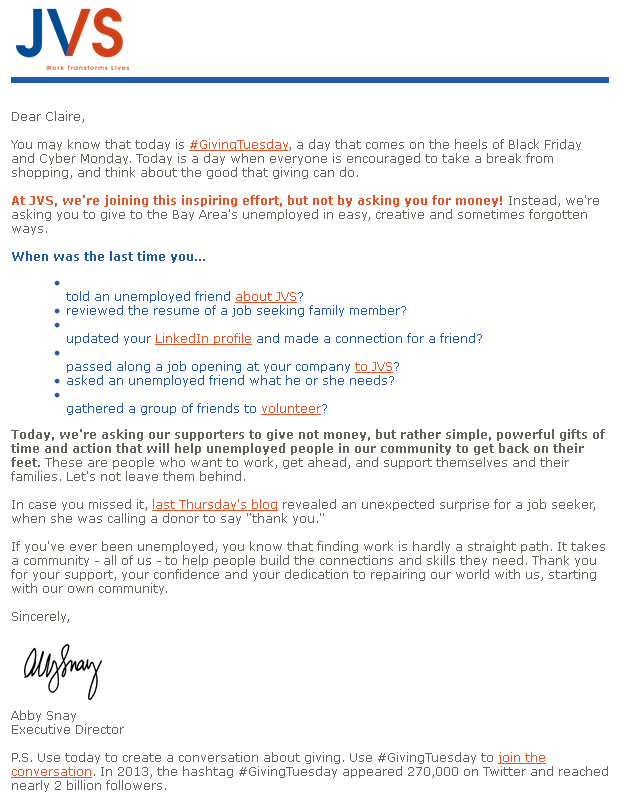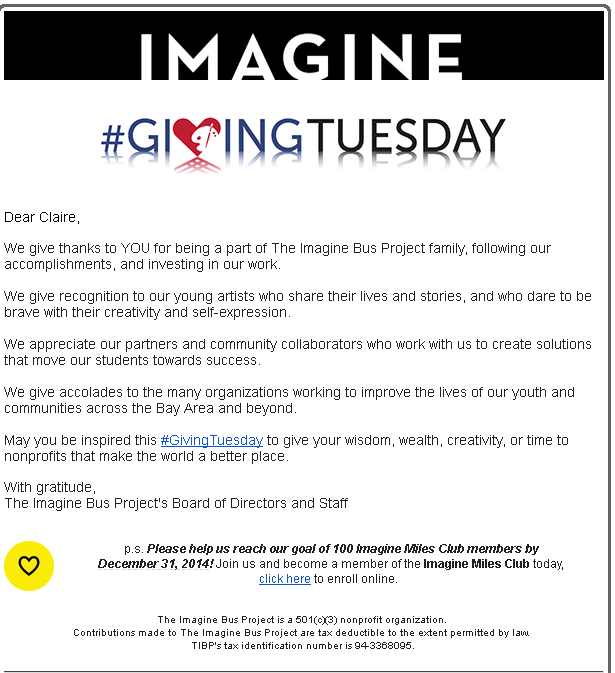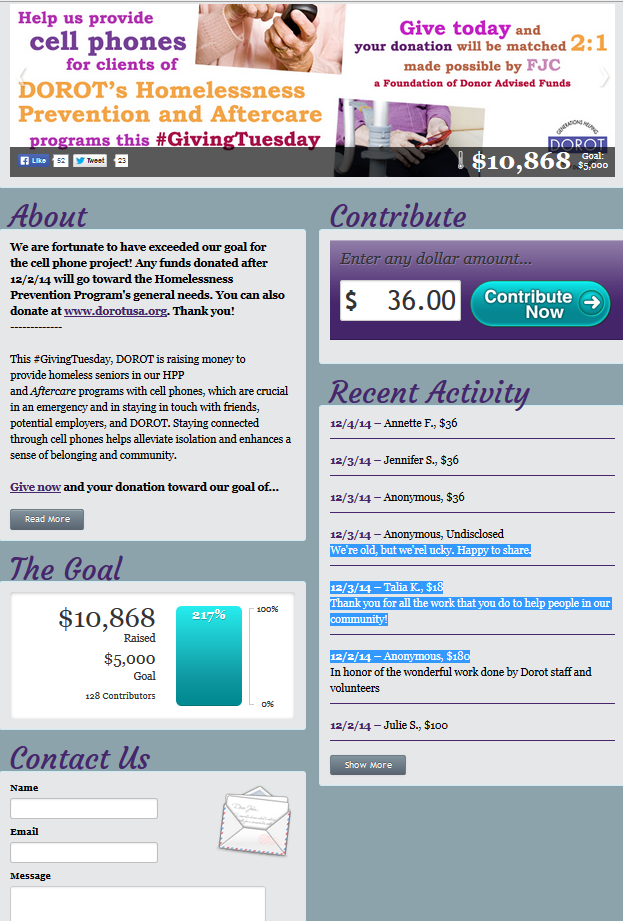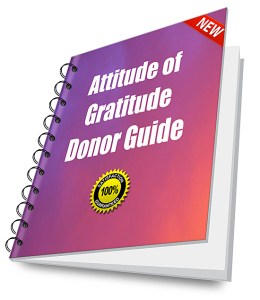 I’ve long been an advocate of turning the tables on #GivingTuesday and using the “giving” part of the day to give to donors rather than add yet one more ask to an already crowded solicitation season.
I’ve long been an advocate of turning the tables on #GivingTuesday and using the “giving” part of the day to give to donors rather than add yet one more ask to an already crowded solicitation season.
If you want gifts, you must give them.
It’s one of those things that sounds good on paper, but in actual implementation it can be less than ideal. Why? Because it comes smack dab in the middle of most folks’ annual campaigns. So there’s often little time to do it right. And it can such your energy and focus on other year-end fundraising efforts.
I’ve got a better choice for you.
Flip the idea and rather than asking folks to make a symbolic gift to you, why don’t you make a gift to them?
You see, even though reports show plenty of money is raised that day, there’s no way to tell if it’s ‘plus’ contributions. In other words, it may simply be cannibalizing your other fundraising efforts. Net/net? You raise the same amount of money, but it takes a lot more effort.
Hmmn… perhaps there’s a better way to get a bigger bang for your buck?
Consider Using November 28th to Reward Donors
Why not do something to make your supporters feel like the heroes they are?
At this time of year we traditionally give gratitude for our blessings. Aren’t your donors among your biggest blessings? Aren’t you grateful to your donors for making your mission possible?
Tell them.Show them.
Express gratitude for all they do during the course of the year to make your mission come to fruition.
Make this special day one of Thanks(for)Giving.
Count your donor blessings by showering supporters with thanks.
Why Giving (Thanks) Tuesday Makes Sense
Giving, sadly, is not always its own reward. Fundraisers must be proactive to give donors the hugs they deserve.
Otherwise, they’ll go someplace else where they feel more appreciated.
I’m not the only skeptic when it comes to #GivingTuesday as it’s currently practiced.
Last year Tom Belford of The Agitator expressed his own doubts. Since I share them, I responded. He followed up with another post, saying:
I was really taken by a great idea suggested by Claire Axelrad, a jujitsu idea really — instead of resisting and griping about #GivingTuesday, why not hijack it?! Capitalize on its visibility and convert it into ‘#GivingThanksTuesday.’
In other words, don’t ask for a symbolic contribution on the day; instead, make a heartfelt gesture of thanks to your donors. A big ‘Thank you’ day!
By choosing the jujitsu route, you need not worry you’ve lost an opportunity — to get a one-time added gift.
Instead, you’ll have gained an even better opportunity — to solidify your donor relationships to create a lifetime of giving!
Tom and his co-author, Roger Craver, doubled down on the jujitsu concept this year by sharing a great example of #GivingThanksTuesday from Heather McGinness, VP of Advancement at Concordia College – New York (I’ll share the specifics in the examples below; it’s numero uno).
There are other skeptics as well. Michael Rosen wrote there is no real evidence of #GivingTuesday success, suggesting we don’t know if it causes people to give more money overall during the busy November/December period. Joe Garecht of The Fundraising Authority, has suggested it encourages ‘spot giving’ that may cannibalize other fundraising, and may not make sense for nonprofits whose resources are stretched thin.
As tempting as it is to jump on the bandwagon, I fall in with the skeptics. Because we ask our donors to give a lot. We don’t thank them enough.
Make Giving(Thanks)Tuesday Your Gratitude Pièce de Résistance!
What if you and your organization do the giving on this day?
What if you center this day on what your donor needs and deserves, rather than on your needs?
November 28th is a great time to put your money where your mouth is when it comes to making donor-centered fundraising a priority. By using #Giving(Thanks)Tuesday as the pièce de résistance of your donor acknowledgment program, you show you’re serious about tackling the biggest problem facing nonprofits today – donor retention.
The Fundraising Effectiveness Project study paints a bleak picture. On average, charities retain just over four out of ten donors each year. For new donors, they retain only two out of ten. Does this not signal to you that you should be doing something active to keep more donors?
Putting in place a robust gratitude program can turn donor retention around. The number one reason folks give for not giving again is that they weren’t thanked. And just thanking folks once won’t seal the deal. You’ve got to do it over and over so it sinks in. The more consistently you practice gratitude, the better.
Why Gratitude Offers a Bigger Bang for Your Buck
Think about this day from your donor’s perspective. Every single charity on their list, and some that aren’t, bombards them with solicitations.
With all the appeals folks receive on this day, you really need to wonder: Is this the best day to ask? You’re already asking for gifts at this time of year. In fact, November and December are by far the biggest giving months of the year. So asking for yet another gift at this time may not really yield as much as you hope it will. Because it just substitutes for another year-end gift they would have given anyway.
Giving Tuesday strategies can be pretty much the opposite of donor-centered.
You have a chance to be the exception!
5 Ways to Put Giving(Thanks)Tuesday in Practice
In A Time to Ask and a Time to Thank I note we are approaching the season of Thanksgiving and holiday goodwill. November 28th comes at the perfect time of year to channel gratitude towards your treasured supporters. It’s a time when many of us take stock of our blessings and tell others why we are thankful to have them in our lives.
1. Create a Full Gratitude Day
Let’s begin with the example of Concordia College-New York, who put together a full day of pure thank you activities. This included on-campus and community activities, sending an email to everyone on their list, with a link to a heartwarming video (uploaded to YouTube) featuring students saying thanks, and a “thank you take-over” on the home page of their website that day. They clearly sat down and thought about everyone who they considered a blessing — students, teachers, neighbors and supporters — and made sure to shower them all with gratitude.
 2. Ask for Gifts of Time and Action
2. Ask for Gifts of Time and Action
I also like this example from JVS in the San Francisco Bay Area, who went the engagement route, listing ways folks can become involved with them other than by giving money. It shows they care about their supporters for more than just their wallets. And it’s a creative way to build stronger relationships that will hopefully lead to increased investment the next time they make an ask.
 Appreciate your supporters for their many and various gifts — not just as donors, but as volunteers, advocates, ambassadors and influencers.
Appreciate your supporters for their many and various gifts — not just as donors, but as volunteers, advocates, ambassadors and influencers.
3. Seize the Opportunity to Give Thanks and Small Gifts
Here’s an example from Imagine Bus Project in Northern California, who also went the pure thank you route. In addition, at the end of their email (which I failed to capture on this screen shot) was an invitation to a free event with hors d’oeuvres, music and an opportunity to take home some of the children’s art. What a nice way to demonstrate gratitude, and also potentially draw in some folks who may wish to become more invested in the future. [Okay, they threw a little annual campaign ask in at the end, but it was close to a pure thank you]
4. An Appeal that’s Not about Money
Here’s an example from DOROT USA, a New York-based social services organization. Two years ago on #Giving Tuesday they asked for donations of cellphones for seniors. Okay, they did ask for money to buy the phones rather than the goods themselves, but it could have been done without money necessarily changing hands. Or they could have offered the option to either drop a phone off or send a check. It’s still good food for thought — and fingers crossed for this year! When you ask for something concrete, like shoes, warm winter coats, new socks, toiletries, kid’s toys or food, people feel they’re directly involved. They like this, and it seems different than their annual monetary gift. So it doesn’t tend to cannibalize your other year-end giving.
When you ask for something concrete, like shoes, warm winter coats, new socks, toiletries, kid’s toys or food, people feel they’re directly involved. They like this, and it seems different than their annual monetary gift. So it doesn’t tend to cannibalize your other year-end giving.
5. A Time to Create a Gratitude Culture
One savvy fundraiser, Meredith, commented last year on the Agitator blog with another take on the day. Her nonprofit’s greatest challenge was helping staff connect with supporters. So they “used the momentum of the noise around #GivingTuesday to have those conversations about the importance of giving internally.”
We get the entire charity (senior management, services staff, finance, IT, and, of course, fundraising) to take time to write hand-written thank you letters to supporters. It has been a great way to get staff across the charity engaged in sharing stories about our work and thinking about the importance of our supporters.
They’re even able to demonstrate the impact. Since they couldn’t thank 100% of their supporters in a single day, they kept a separate control group and tracked results. Six months on, there was an uplift in value from the group of donors who received these personal thank yous, an effect that increased after a year. Feedback from staff was also overwhelmingly positive. Win-win all around.
Final Thoughts:
Think about having a #Giving(Thanks)Tuesday at your nonprofit this year. A day where you turn the tables and, rather than asking for gifts, you give them!
If you do plan to use this occasion for fundraising, make sure you have a robust gratitude program in place. Don’t make thank you an afterthought. Plan ahead to thank your supporters. Then thank them again. All through the year.
Whatever you do, don’t just stuff your “#GivingTuesday donors into your database, send out automated receipts, count up the results to report to your board. Really, truly make sure these folks feel thanked for having done something selfless and special.
Giving thanks is just as easy as asking for a monetary gift, and I believe the long-term value will be well worth your jujitsu.
What are You Doing for Donor Gratitude Season?
Ready to respond promptly and personally to the onslaught of gifts you’ll receive this season? If not, get going now! Because your thank you is what sets you up for your next gift. And it’s much cheaper to renew an ongoing donor than recruit a new on. Get a leg up with the Donor Retention and Gratitude Playbook — a 6-Volume set of Companion eGuides to help you put in place a full-blown acknowledgement program and transition your culture to an organization-wide “Attitude of Gratitude.” Get a ‘Bargain Bundle’ at a generous discount – almost a third less than buying them separately — or just get the ones you need. If you don’t find them well worth your while, I’ll refund your money or make a donation to your nonprofit – with deep gratitude for all you do to make our world a better place.






As much as I love the principle of elevating philanthropy in the public’s awareness, something about #Giving Tuesday hasn’t felt right in my gut all these years. Thank you for articulating the inconsistency and confusion that may be present in the minds of our donors. My community instituted a local 24-hour give-a-thon a few years ago, and I’ve also felt the angst about asking again in November/December for that as well. But I LOVE the idea of making it a day of pure thanks and gratitude!
Thanks for weighing in Jeri. Let me know if you give it a try, and what your results are. I often say “If you want gifts, you must give them.” 🙂